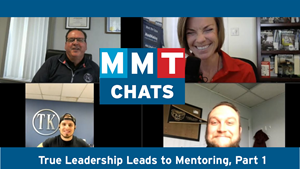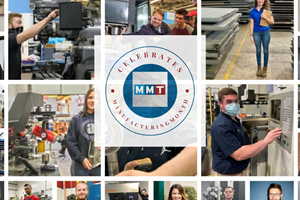How to Manage Change
If there’s one word that captures the essence of what is occurring in the world today, it’s change.
Share
Read Next
If there’s one word that captures the essence of what is occurring in the world today, it’s change. Downsizing, reorganizing and cutting costs, are now the norm when it comes to surviving during this economic slow down. No industry is exempt. Even the most venerable and conservative institutions are undergoing significant change just to survive. For the moldmaking industry, in spite of the slight improvement some are reporting, a full recovery is not predicted to occur
in the immediate future.
No one likes the change that has occurred—least of all business owners especially when it is a negative turn of events over a period of years that dramatically impacts their bottom line. Unfortunately, while it may not be easy, you need to deal with it the best that you can.
Ten Ways to Implement Change Successfully
1. Communicate the reason for your hard choices and the changes you need to make. Communication is always important, but it is critical in a changing business environment. Make every effort to ensure that all employees understand the hard choices you’ve had to make and how difficult it has been for you, personally. They will respect you for it.
Talk to them about your competitive strategy and the changes you want to make. Make them a part of it so that they can assume a degree of ownership in the situation. Ask for their ideas and input. Communicate your goals and direction to every level of the company.
Use sincere language, such as: “I fully understand that things are going to be different from what they have been in the past, but I’m committed to ensuring that we make it through these tough times, and I’m counting on you to help me make it happen. Here’s what I need from you ...” Then tell them.
2. Involve your management team in strategic planning and develop them to be change coaches. Your entire management team needs to be involved with creating your competitive strategy and on board with the changes you want to implement. Share the role you expect them to have and provide a detailed set of actions. Make sure they understand that they are the coaches who will spur the team forward and their job is to make sure your entire team is aligned with your competitive strategy. Remind them to think and act as dynamic leaders who will provide the inspiration and encouragement to your entire workforce.
3. Establish a “change” team. Follow the example of a manufacturer who has established a change center in its headquarters. Even appoint top performers to be on your change team to lead the way to deploy the change management process. Let them know you understand that they already have a heavy workload, but you are confident they can help make a difference in your company. Choose people who have high levels of credibility in the company; give them direct access to customers. Let the team know it is expected to help identify problems and focus on offering solutions.
4. Establish an atmosphere and culture of open communication. Open communication is important in every organization at all times. It becomes even more critical when implementing change. As you begin planning organizational changes, consider developing a concurrent communication strategy to remind people about the nature of the changes, the expectations and the progress that is being made. In today’s changing business environment, employees quickly lose their motivation if they are not involved and kept informed of changes going on around them. The less they are informed, the more it will have a negative impact on their performance. Consistently ask for ideas and suggestions from employees. Encourage them to come forward to identify any service flaws that might exist, any wasteful spending they see, ways to streamline operations and any other areas where you need help.
5. Introduce change gradually whenever possible. You may feel your people are ready to respond to change, but they may not be able to absorb the changes as quickly as you like. It takes time to assimilate new information, learn new systems or procedures, and to do things in a new and different way. Give your staff time to understand the first wave of changes before introducing more. If there needs to be a major change, try to anticipate the reaction and prepare your staff to the best of your ability. This empathetic approach will help everyone concerned in the long run. Keep in mind that while you may be committed to the changes, others will not have had the time to recognize the problem and understand the need for the changes. You will be setting yourself up for misunderstanding. You must make sure they understand what your needs and expectations are.
6. Be in tune to difficulties some may be experiencing. Recognize that change affects each individual differently. Some people are more adaptable than others. Many top performers will roll up their sleeves to make things work—moving out of their comfort zone instantly. Others may be completely overwhelmed. Let them know you understand the challenges they are facing and that you are there to help them through it. Here, remember the importance of open communication. Keep your door open to allow people to come in to discuss any apprehension.
7. Manage resistance. Human beings are basically creatures of habit. They like doing things the same way. Doing things differently takes them out of their comfort zones. Some people may resist, and hold back their team and, consequently, your company. Talk to any person who comes to work with a chip on his or her shoulder. Ask the person who is making negative remarks and pulling down morale to refrain from doing so. Ask them what you can do to help them.
8. Be a role model. It is up to you as their leader to maintain employee morale through change. Set the tone; be a role model and be an example for others to follow. During tough times people will always watch how their leader is acting.
9. Take the time to train. To reduce the loss of productivity during change, make sure your people have the necessary skills to succeed. Training must be a top priority. The time and money you invest in training will eventually pay off in increased profits and service quality (see Training Tips sidebar). Training demonstrates that you appreciate their efforts, want them to feel as though they are a strong part of your team, and also that you plan on keeping them working for you. In essence, training gives your employees a shot in the arm.
10. Alleviate job pressure. Meeting the demands placed upon people during the change process requires managing job pressure for yourself and others. What is occurring for moldmakers is serious, but the stress can be reduced by keeping an effort to maintain high morale. For example, one business owner holds an annual customer event. Employees and their families are included as well as customers’ families. In spite of the tough economy, this smart businessman recognizes the importance of continuing this management/employee and customer relationship building activity. Another way to alleviate job pressure is to find simple ways to celebrate even the smallest successes. They will pay off big.
The Bottom Line
No one wants to be extinct. Unfortunately, we sometimes (even unknowingly) put up our own roadblocks to success. We wait for things to turn around, complain loudly and refuse to take on the challenge. We simply can’t adapt. The truth is that the business environment has changed, it’s business not as usual. We must accept it and move forward. We can choose to embrace new ways of doing business or be left behind.
Related Content
ICYMI: MMT Chats: True Leadership Leads to Mentoring, Part 1
This trio from TK Mold and Engineering in Romeo, Michigan, joins me to discuss the role of leadership and culture in mentorship. This episode is brought to you by ISCAR with New Ideas for Machining Intelligently.
Read MoreConsiderations for Mold Base Material Selection
Choosing the right material can greatly affect the profitability and cost of your application.
Read MoreWomen Impacting Moldmaking
Honoring female makers, innovators and leaders who are influencing our industry's future.
Read More2021 30 Under 30 Honors Program: Mentoring in the Next-Generation of Moldmaking Professionals
Young professionals are vital to the moldmaking industry, and it is important to acknowledge those making strides in shaping the industry's future. MoldMaking Technology recognizes the industry's young talent through its 30 Under 30 Honors Program.
Read MoreRead Next
How to Use Strategic Planning Tools, Data to Manage the Human Side of Business
Q&A with Marion Wells, MMT EAB member and founder of Human Asset Management.
Read MoreAre You a Moldmaker Considering 3D Printing? Consider the 3D Printing Workshop at NPE2024
Presentations will cover 3D printing for mold tooling, material innovation, product development, bridge production and full-scale, high-volume additive manufacturing.
Read MoreHow to Use Continuing Education to Remain Competitive in Moldmaking
Continued training helps moldmakers make tooling decisions and properly use the latest cutting tool to efficiently machine high-quality molds.
Read More









_300x250 3.png;maxWidth=300;quality=90)
.jpg;maxWidth=300;quality=90)



.png;maxWidth=300;quality=90)














